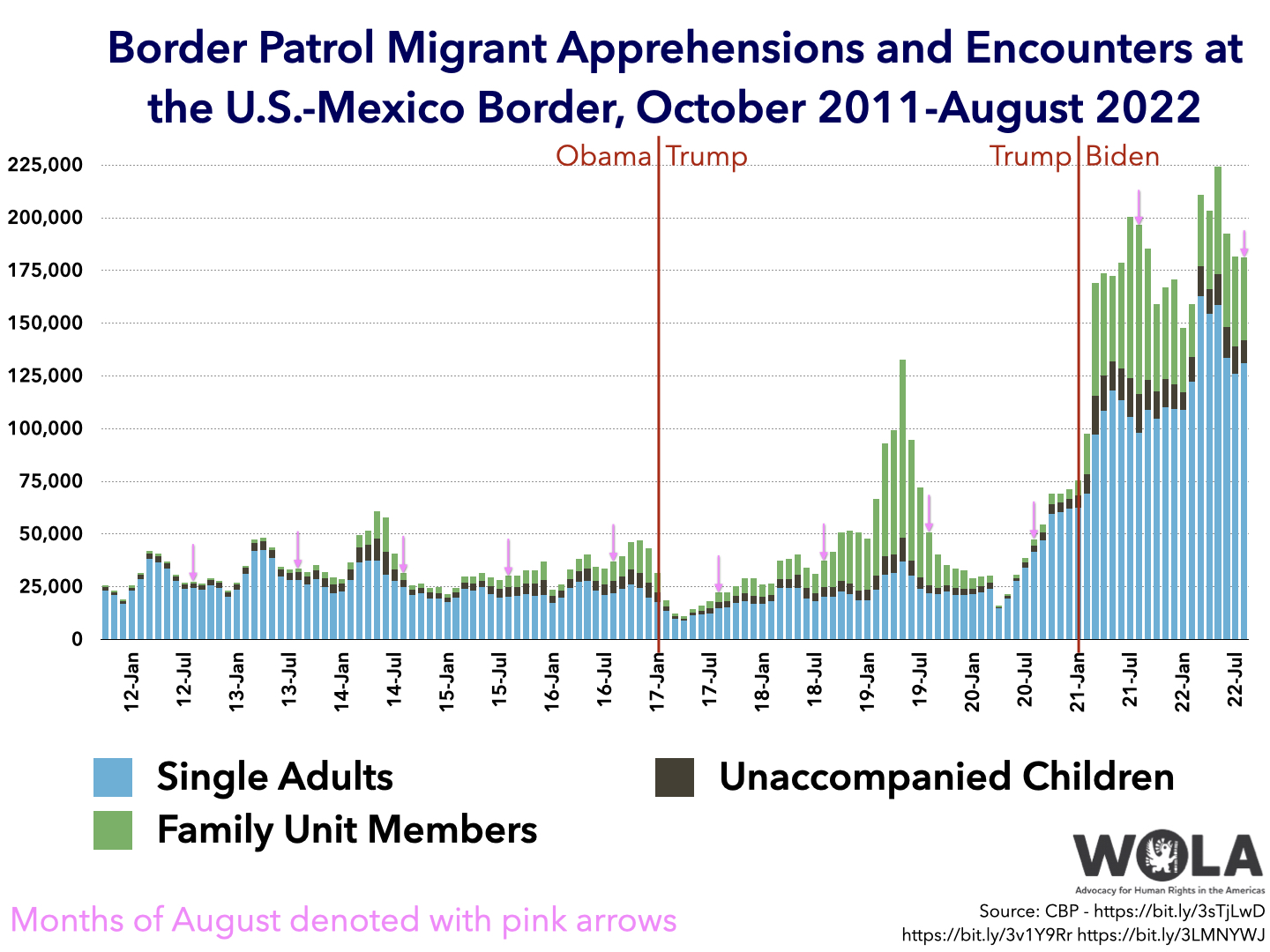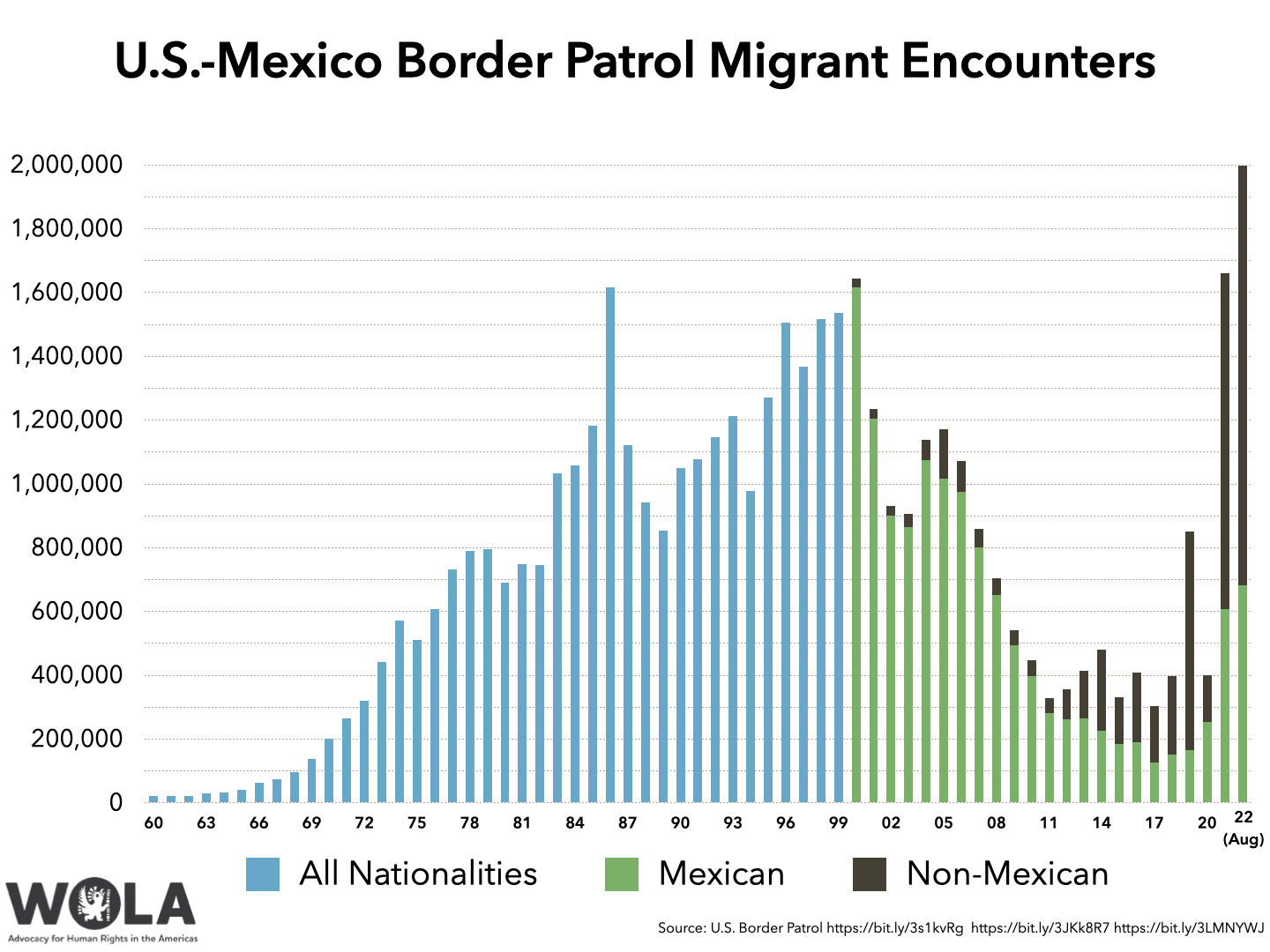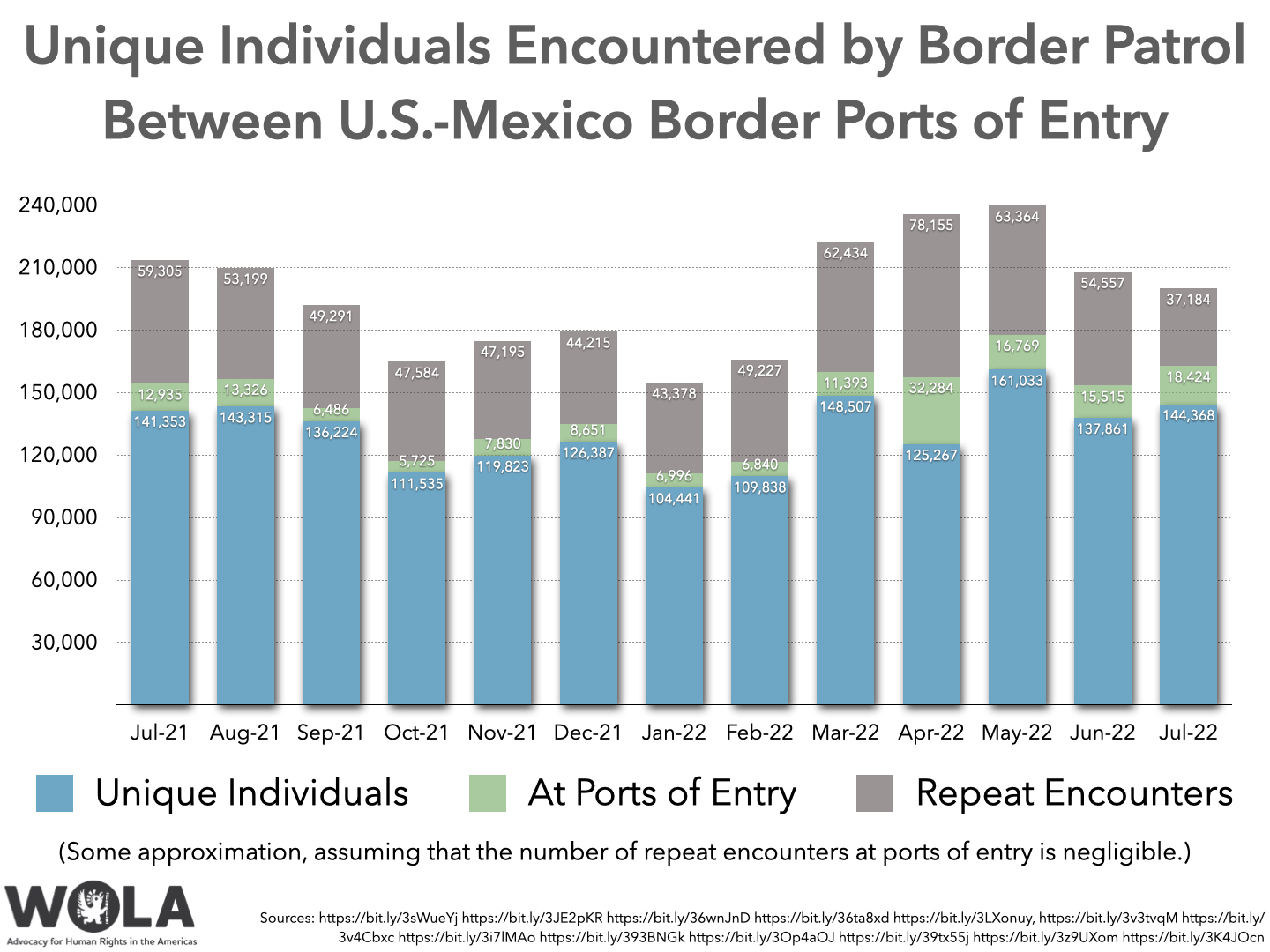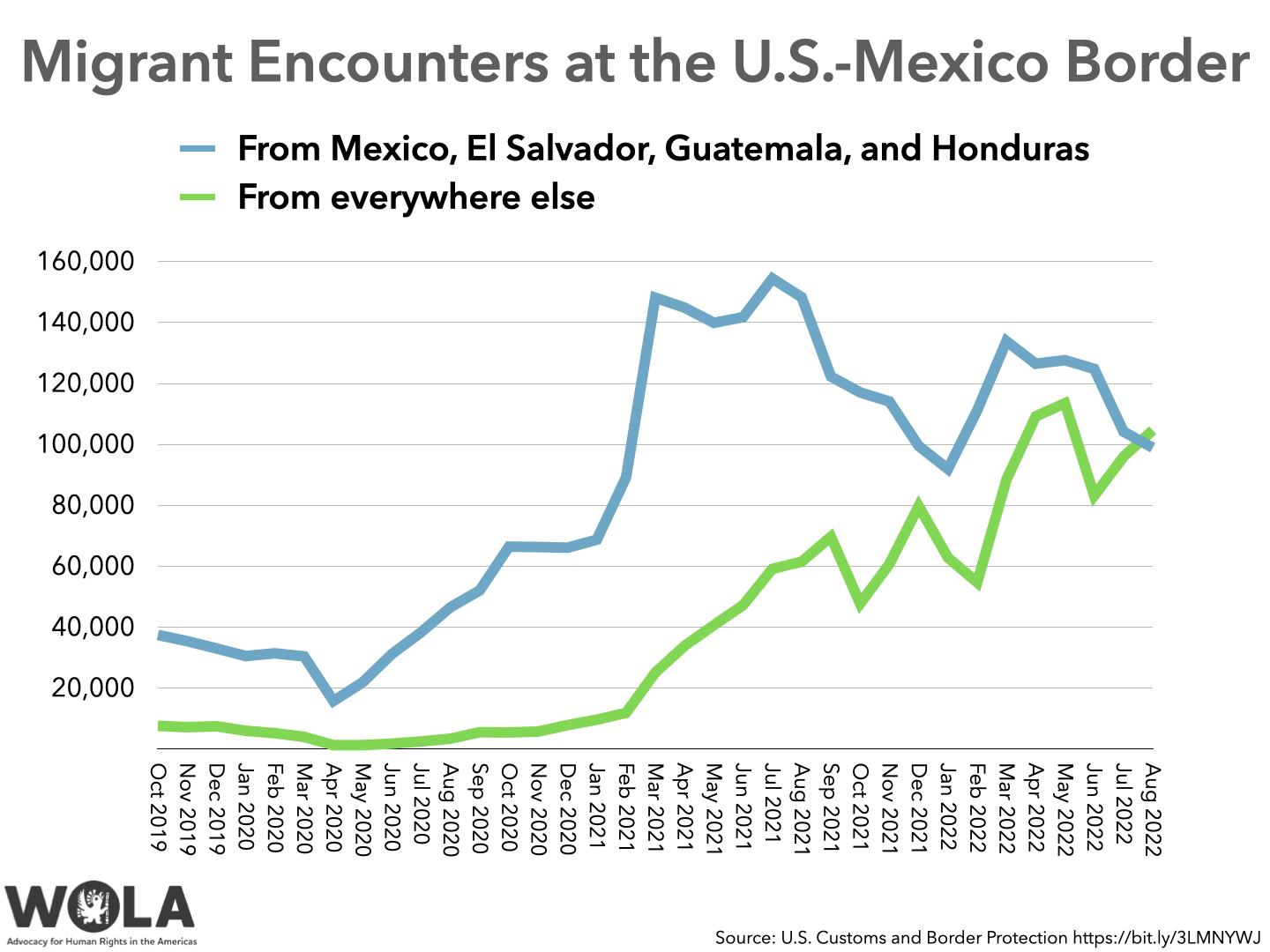With this series of weekly updates, WOLA seeks to cover the most important developments at the U.S.-Mexico border. See past weekly updates here.
This week:
Two million migrant encounters in eleven months
With a September 19 release of data covering August, U.S. Customs and Border Protection (CBP) reported that, for the first time in a single fiscal year (October-September), its personnel had taken migrants into custody 2 million times at the U.S.-Mexico border.
CBP encountered migrants 203,597 times during August: 22,437 at land border ports of entry, and 181,160 in the areas between the ports of entry where CBP’s Border Patrol component operates. The Border Patrol apprehensions number was the smallest since February 2022, ranking 9th of the 19 full months since Joe Biden took office.
Title 42 exceptions at the ports of entry
The port-of-entry number was the second-largest monthly total in the nearly 11 years of records that WOLA has available (since October 2011), exceeded only by April 2022 when the ports processed over 20,000 people fleeing Ukraine. It indicates that CBP’s Office of Field Operations was allowing an increased number of exemptions to the Title 42 pandemic policy, for asylum-seeking migrants deemed most vulnerable.


In August, CBP admitted and processed 15,906 asylum seekers at ports of entry under this system of Title 42 exemptions, a 37 percent increase over July. These have been happening at six ports: Hidalgo (Rio Grande Valley, Texas, 5,446 in August); San Ysidro (San Diego, California, 4,403); Laredo (Laredo, Texas, 2,847); Eagle Pass (Del Rio, Texas, 1,646); Paso del Norte (El Paso, Texas, 1,218); and Nogales (Tucson, Arizona, 346).
During the week of September 12, though, CBP abruptly suspended Title 42 exemptions at several ports of entry, including Hidalgo, the busiest. “The decision came after reports of Haitian asylum-seekers protesting at shelters in Reynosa, Mexico, and growing repeatedly angry after their names were not called for admittance,” according to Border Report. The migrant population currently waiting for a chance to seek asylum in Reynosa, across from Hidalgo and McAllen, Texas, is 85 percent Haitian, totaling about 7,000 Haitian citizens, according to Sr. Norma Pimentel of Rio Grande Valley Catholic Charities. As of September 19, Title 42 exemptions were resuming at Hidalgo but remained suspended in Laredo, according to Border Report.
Expulsions
Under Title 42, a policy prolonged by federal court order in May, CBP seeks to expel migrants from the United States, in the name of public health, very quickly and without affording them a chance to ask for asylum. Even as the pandemic shows strong signs of easing, CBP expelled 36 percent of migrants it encountered in August, including 48 percent of single adults and 12 percent of families. The number of migrants encountered by Border Patrol and actually processed under regular U.S. immigration law was 1,020,233, a number that Border Patrol has in fact exceeded in 19 previous fiscal years, though not since 2006.
Including both expelled and processed migrants, the August numbers pushed overall CBP encounters to 2,150,639 for the 11 months between October 2021 and August 2022: 1,997,769 taken into custody by Border Patrol and 152,870 at ports of entry. All three numbers set full-fiscal-year records.

Adding expulsions to those deported under regular immigration law, CBP reported removing people encountered at the U.S.-Mexico border 1,300,467 times in 2022. That would leave about 850,000 of 2022’s migrants still in the United States facing immigration proceedings: some in custody and most released into the U.S. interior. Since Joe Biden’s January 2021 inauguration, the New York Times reported that “more than one million undocumented immigrants have been allowed into the United States temporarily after crossing the border.”
“Encounters” versus “individual people”
Title 42’s rapid expulsions tend to facilitate repeated attempts to cross the border, and 22 percent of CBP’s August encounters were with migrants who had already been taken into custody at least once in the previous 12 months. The agency actually encountered 157,921 individual people in August, of whom about 135,000 were encountered by Border Patrol. That was Border Patrol’s smallest “individuals” number since April.

CBP’s encounters with unaccompanied children fell to 11,365 in August, the fewest since January and 17th of the Biden administration’s 19 full months in office. The agency had a daily average of 422 unaccompanied kids in custody in August, down from 562 in July.
Migrants’ nationalities, especially Venezuela
The most notable aspect of August’s border migrant encounters was the migrants’ countries of origin. The number from Mexico and Central America’s “northern triangle” (El Salvador, Guatemala, and Honduras) was smaller (49 percent) than the number of migrants from the rest of the world. This was assuredly the first time this has ever happened: migrants from these four countries consistently comprised over 90 percent of the total as recently as 2019 (and 89 percent in 2020). Now, the lines on this chart have crossed for the first time:

Mexico and the Northern Triangle are the four countries whose citizens Mexico allows CBP to expel across the land border under Title 42, and they make up over 99 percent of Title 42 expulsions. August’s encounters with citizens of those countries were the fewest since January, ranking 17th of the Biden administration’s 19 full months, and one-third fewer than August 2021.
Because of Title 42’s rapid expulsions and ease of re-entry, CBP often encounters citizens of these four nationalities more than once. The agency took into custody 56,979 individual Mexicans, Guatemalans, Hondurans, and Salvadorans in August, just 36 percent of that month’s “unique individuals” total and 43 percent fewer than a year before.
Of countries whose citizens were encountered over 5,000 times at the US-Mexico border in August, those that saw the most robust increases were Venezuela (up 92 percent from June to August), Haiti (up 61 percent, nearly all of them arriving at ports of entry as Title 42 exemptions), and Brazil (up 43 percent).

Citizens of Venezuela (August’s number-two country), Cuba (number three), and Nicaragua (number seven) made up 35 percent of CBP’s “unique individuals” last month, up 175 percent over August 2021.
As discussed in WOLA’s September 16 Border Update, arrivals from Venezuela have been increasing since March, as migrants from that country began arriving over long land routes from South America. (This was after Mexico’s January decision, at strong U.S. suggestion, to begin requiring visas of visiting Venezuelans.)
CBP’s September 19 release blamed “failing communist regimes in Venezuela, Nicaragua, and Cuba” for “driving a new wave of migration across the Western Hemisphere,” including the increase at the border. While these regimes repress their populations amid plummeting living standards, another factor underlying the migration increase is the impossibility of expelling or deporting migrants to Caracas, Havana, or Managua after they reach U.S. soil.
The overland journey
Venezuelans’ overland journey requires passage through the roadless, dangerous Darién Gap jungle of northwest Colombia and eastern Panama. Over 31,000 migrants—1,000 per day—passed through this ungoverned region in August; 22,500 were Venezuelan. Of the 102,000 migrants who came through the Darién during 2022’s first 8 months (68,000 of them Venezuelan), 24 percent were female, and 14,571 were children.
“There is much corruption and evil things” in the Darién, Venezuelan migrant Reina Gil told Border Report in El Paso. “We saw dead people. A river nearly drowned us. We were robbed. We heard of rapes and many ugly things. I am telling you this so that people will know it is not easy to get here.” A migrant named Gerardo added, “When you come out, people cry, they embrace each other. You have mixed feelings because you accomplish something that not everyone can. You see people dehydrate, starving, unable to walk because their feet get swollen. People just leave them there.” The migrants also told Border Report of “having to constantly pay off ‘transportation people’ (smugglers)” to get across Mexico, and having to dismount repeatedly from vehicles and walk around Mexican authorities’ road checkpoints.
El Paso
The rapidly growing Venezuelan migrant population had been arriving principally in Border Patrol’s Del Rio sector, in mid-Texas. There, many migrants have died by drowning in the swollen Rio Grande. In response, smugglers have begun routing migrants far upstream to El Paso, Texas, where the river is far shallower.
As WOLA’s September 16 update noted, that has strained CBP’s processing capacity in the sector, as well as the capacity of El Paso’s community of short-term shelters for asylum-seeking migrants released from custody. Border Patrol has managed to “de-compress” its El Paso facilities, avoiding chaos and backlogs in migrant processing by employing “processing buses” and transferring some migrants to other sectors. Shelters, though, are struggling to keep up, and local media report that migrants are still sleeping outside downtown El Paso’s Greyhound bus station. The city prohibits camping on sidewalks, Border Report explained: “the migrants, instead, are sleeping on flattened tents.”
September migrant arrivals at the U.S.-Mexico border appear to be increasing over August as temperatures cool. “Over the past few days, there have been about 8,700 crossings a day, which is historically high,” according to the New York Times. NBC News notes that “White House officials have previously set 9,000 per day as an internal trigger to begin what they refer to as ‘interior processing,’ where migrants are flown or bused from the border to interior cities where shelters can take care of them” as they await immigration proceedings and find places to live, often with relatives or other U.S.-based contacts.
Troubling aspects of the Florida governor’s Martha’s Vineyard stunt
While the federal government has not yet begun transporting asylum seekers to the U.S. interior, Republican governors have been using their states’ funds to send migrants, on an apparently voluntary basis, to U.S. jurisdictions governed by Democrats. Texas Gov. Greg Abbott has attracted much attention in conservative media by sending busloads of asylum-seeking migrants to Washington and New York after their release in Texas. Two such buses arrived outside the official residence of Vice President Kamala Harris in the pre-dawn hours of September 15.
The migrant-removal stunt that has received the strongest blitz of media attention is Florida Gov. Ron DeSantis’s (R) contracting of planes that took 48 mostly Venezuelan asylum seekers from San Antonio, Texas to Martha’s Vineyard, a Massachusetts resort island, on September 14. The planes arrived without any prior notice to local authorities, abandoning the confused migrants at the airport (along with a videographer who provided footage to Fox News and other outlets).
Serious questions surround the legality of DeSantis’s stunt, as testimonies point to the migrants being deceived and misinformed about where they were going, casting doubt on whether their participation was truly voluntary. The sheriff of Bexar County, Texas, which includes San Antonio, launched a criminal investigation on September 20, contending that the migrants had been “lured” away from a service provider in the city “under false pretenses.” Sheriff Javier Salazar said he is prepared to work with federal authorities should they launch their own investigation, as California Gov. Gavin Newsom (D) and other Democrats have called on the Justice Department to do.
“It seems like there were clear elements of deception in this particular case. It seems like there was fraud in terms of their transport and what was represented to them,” Julie Dahlstrom, of Boston University Law School’s Immigrants’ Rights and Human Trafficking Program, told CBS News. She added, though, that whether the evidence points clearly to a violation of the law is a “difficult legal question.”
Also on September 20, advocacy groups Alianza Americas and Lawyers for Civil Rights filed a class-action lawsuit on the Venezuelan migrants’ behalf in Massachusetts federal court. “In or around September 2022, Defendants and their unidentified accomplices designed and executed a premeditated, fraudulent, and illegal scheme centered on exploiting [migrants’] vulnerability for the sole purpose of advancing their own personal, financial and political interests,” it reads. The suit seeks a minimum of $75,000 per migrant as compensation for having “suffered economic, emotional, and constitutional harms as a result of Defendants’ intentional, reckless, and negligent conduct.”
The suit, which draws from some of the 48 migrants’ accounts of what happened to them, offers troubling details about Gov. DeSantis’s stunt, as have other media reports filed in the days since the planes landed at Martha’s Vineyard.
Border technology and civil liberties concerns
Sen. Ron Wyden (D-Oregon), a member of the Senate Select Committee on Intelligence, sent a September 15 letter to CBP voicing serious concerns about the electronic privacy of travelers who pass through U.S. ports of entry, including land border crossings and airports. Sen. Wyden accused CBP of “pressuring travelers to unlock their electronic devices without adequately informing them of their rights” and “downloading the contents of Americans’ phones into a central database, where this data is saved and searchable for 15 years by thousands of Department of Homeland Security employees, with minimal protections against abuse.”
The Washington Post and Gizmodo reported on the letter, and on CBP’s apparent power to carry out “advanced searches” of travelers’ phones—including those of U.S. citizens—if they have a “reasonable suspicion” that the individual is breaking the law or poses a “national security concern.”
Even without such suspicion, CBP claims the power to access travelers’ electronic devices, looking at “anything that ‘would ordinarily be visible by scrolling through the phone manually,’ including contact lists, calendar entries, messages, photos and videos,” the Washington Post explained citing a 2018 CBP filing. With the “reasonable suspicion” standard, CBP can copy the entire contents of the phone or device. “That data is then stored in the Automated Targeting System database, which CBP officials can search at any time.”
CBP is collecting data from as many as 10,000 border-crossers’ devices each year. The agency then retains the copied data for 15 years. Sources told the Washington Post that about 2,700 or 3,000 CBP personnel have access to this collected data, all without a warrant.
Other civil liberties concerns emerged in a September 16 Guardian article about 189 sensor towers being built along the border on a CBP contract with Anduril, a technology company founded by Oculus VR founder Palmer Luckey. Anduril is backed by Peter Thiel, a PayPal co-founder who has funded Donald Trump and far-right U.S. political candidates like Senate hopefuls Blake Masters in Arizona and J.D. Vance in Ohio. Anduril’s towers use an artificial intelligence system, “Lattice,” that identifies and tracks people and vehicles autonomously.
Other news